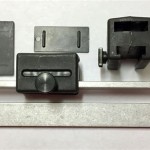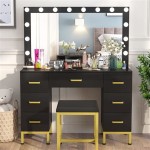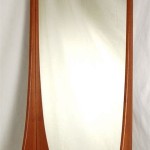Can You Put A Mirror On A Door? Exploring the Possibilities, Challenges, and Considerations
Mirrors are versatile design elements that can enhance the aesthetics and functionality of interior spaces. They reflect light, create the illusion of spaciousness, and serve as practical tools for grooming and dressing. Integrating a mirror onto a door presents a unique opportunity to maximize these benefits, but the process involves careful consideration of several factors.
The feasibility of attaching a mirror to a door depends on the door type, size, and material, as well as the size and weight of the mirror itself. Proper installation techniques and appropriate adhesives are crucial for ensuring the mirror's stability and preventing damage to the door or the mirror. This article will explore the various aspects of this undertaking, outlining the possibilities, challenges, and key considerations involved in successfully integrating a mirror onto a door.
Understanding Door Types and Their Suitability
The type of door significantly impacts the ease and success of mirror installation. Different door constructions offer varying levels of structural integrity and surface compatibility with adhesives. The most common door types include hollow-core doors, solid-core doors, mirrored closet doors, and panel doors, each presenting its own set of considerations.
Hollow-core doors are lightweight doors typically found in interior spaces. They consist of a thin veneer of wood or composite material surrounding a hollow interior, often filled with cardboard or a honeycomb structure for minimal support. While their lightweight nature might seem advantageous, the lack of substantial internal support makes them less suitable for attaching heavy mirrors. The adhesive may not adequately bond to the thin veneer, and the weight of the mirror could potentially cause the door to warp or buckle over time. Smaller, lightweight mirrors may be considered, but careful assessment of the door's structural integrity is paramount.
Solid-core doors, in contrast, offer a more robust and stable surface. These doors are constructed with a solid core of wood, particleboard, or other dense materials, providing a significantly stronger foundation for attaching a mirror. The solid core allows for a more secure and lasting bond with adhesives, minimizing the risk of warping or detachment. Solid-core doors are generally more resistant to impact and wear, contributing to the overall longevity of the mirror installation. However, the increased weight of a solid-core door must be considered, particularly if the door hinges are not designed to handle the additional load.
Mirrored closet doors are specifically designed to incorporate mirrors, typically spanning the entire door surface. These doors often feature a metal or wooden frame surrounding the mirror, providing structural support and a secure attachment point. The installation process for mirrored closet doors usually involves specialized hardware and techniques, ensuring the mirror is securely integrated into the door frame. Attempting to add an additional mirror to an existing mirrored closet door may be unnecessary and potentially destabilize the existing structure.
Panel doors, also known as raised panel doors, feature recessed or raised panels surrounded by a frame. Attaching a mirror to a panel door requires careful consideration of the panel's surface area and stability. Adhering a mirror directly to a recessed panel may not provide sufficient support, while attaching it to a raised panel could create an uneven surface. The best approach often involves selecting a mirror that fits within the dimensions of a panel or attaching it to the frame surrounding the panels, ensuring a flush and stable surface.
Selecting the Right Mirror and Adhesive
The choice of mirror and adhesive is crucial for ensuring a successful and long-lasting installation. The mirror's size, weight, and thickness should be carefully considered in relation to the door type and its load-bearing capacity. The adhesive must be specifically designed for bonding mirrors to the door's surface, providing a strong and durable connection without damaging the mirror's reflective coating. Incompatible adhesives can dissolve the silvering on the back of the mirror, leading to discoloration and degradation.
Mirror weight is a primary concern. Heavier mirrors exert more stress on the door and the adhesive bond, increasing the risk of detachment or structural damage. It is advisable to select a lighter mirror option, such as thinner glass or acrylic mirrors, particularly for hollow-core doors or older doors with weakened hinges. The dimensions of the mirror should also be proportionate to the door's size, avoiding an overly large mirror that could overwhelm the door's structure.
Adhesive selection is equally critical. Construction adhesives specifically formulated for mirrors are readily available at hardware stores. These adhesives are designed to provide a strong, permanent bond without damaging the mirror's backing or the door's surface. Avoid using generic adhesives that may contain solvents or chemicals that can react with the mirror's silvering. When selecting an adhesive, it is crucial to read the manufacturer's instructions carefully, ensuring that it is compatible with both the mirror and the door material. It is also essential to consider the adhesive's drying time and curing process, allowing sufficient time for the bond to fully develop before subjecting the mirror to stress or movement.
In addition to adhesive, mechanical fasteners, such as clips or brackets, can provide added security, especially for larger or heavier mirrors. These fasteners can be strategically placed around the mirror's perimeter to distribute the weight and prevent slippage. However, the use of mechanical fasteners requires careful planning to avoid damaging the door or the mirror. It is important to use appropriate screws or anchors that are compatible with the door material and to avoid over-tightening, which could crack the mirror.
Installation Techniques and Safety Precautions
Proper installation techniques are essential for a safe and aesthetically pleasing result. Before commencing the installation, it is important to gather the necessary tools and materials, including a level, measuring tape, pencil, adhesive, mirror clips (if desired), and safety glasses. Thoroughly clean the door surface to remove any dust, dirt, or grease, ensuring a clean and optimal bonding surface. Marking the mirror's position on the door beforehand will help ensure accurate placement.
Apply the adhesive according to the manufacturer's instructions, typically in a series of vertical beads or dots across the back of the mirror. Avoid applying adhesive too close to the edges of the mirror to prevent squeeze-out when it is pressed against the door. Carefully position the mirror on the door, using a level to ensure it is straight and plumb. Press the mirror firmly against the door, applying even pressure across the entire surface to ensure a good bond. If using mirror clips, install them according to the manufacturer's instructions, securing the mirror in place while the adhesive cures. Allow the adhesive to dry and cure completely, following the manufacturer's recommended drying time, before removing any temporary supports or applying any stress to the mirror.
Safety precautions are paramount during the installation process. Always wear safety glasses to protect your eyes from debris or shattered glass. When handling a mirror, use gloves to prevent fingerprints and smudges. Exercise caution when cutting or drilling into the door, avoiding any electrical wiring or plumbing that may be concealed within the door frame. If you are unsure about any aspect of the installation process, it is best to consult a professional contractor or handyman to ensure the job is done safely and correctly. If the mirror is damaged during installation, handle the broken pieces with care, using gloves and a broom to collect the shards. Dispose of the broken glass properly to prevent injury.
By carefully considering the door type, selecting the appropriate mirror and adhesive, and following proper installation techniques, it is possible to successfully integrate a mirror onto a door, enhancing the aesthetics and functionality of the space. However, it is crucial to prioritize safety and to seek professional assistance if needed to ensure a safe and long-lasting installation.

Framing Out A Mirror That S Mounted On Door Young House Love

Saving Space And Gaining Style With Over The Door Mirrors

Over The Door Hanging Mirrors A Comprehensive Guide

Easily Mount A Door Mirror Without Hardware

3 Ways To Hang A Door Mirror Wikihow

Over The Door Hanging Mirrors A Comprehensive Guide

Framing Out A Mirror That S Mounted On Door Young House Love

Over The Door Mirror Ideas

Over The Door Hanging Mirrors A Comprehensive Guide

Framing Out A Mirror That S Mounted On Door Young House Love








